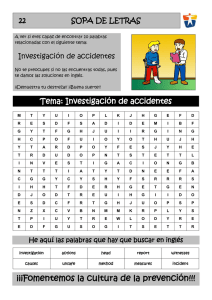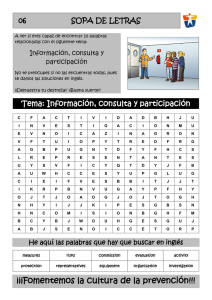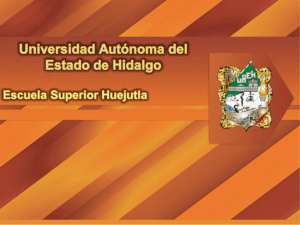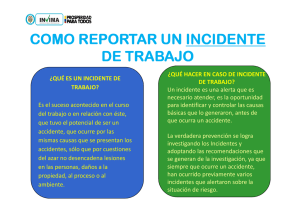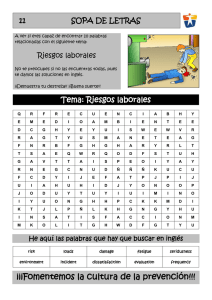Incident Investigation - National Safety Council
Anuncio
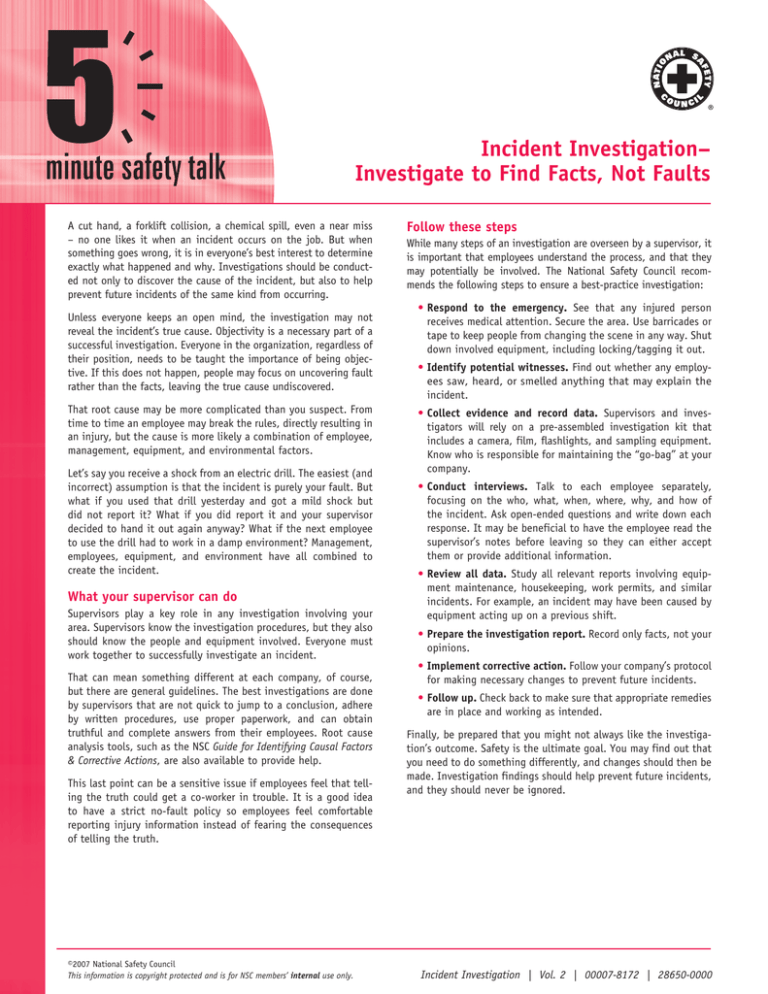
Incident Investigation– Investigate to Find Facts, Not Faults A cut hand, a forklift collision, a chemical spill, even a near miss – no one likes it when an incident occurs on the job. But when something goes wrong, it is in everyone’s best interest to determine exactly what happened and why. Investigations should be conducted not only to discover the cause of the incident, but also to help prevent future incidents of the same kind from occurring. Unless everyone keeps an open mind, the investigation may not reveal the incident’s true cause. Objectivity is a necessary part of a successful investigation. Everyone in the organization, regardless of their position, needs to be taught the importance of being objective. If this does not happen, people may focus on uncovering fault rather than the facts, leaving the true cause undiscovered. That root cause may be more complicated than you suspect. From time to time an employee may break the rules, directly resulting in an injury, but the cause is more likely a combination of employee, management, equipment, and environmental factors. Let’s say you receive a shock from an electric drill. The easiest (and incorrect) assumption is that the incident is purely your fault. But what if you used that drill yesterday and got a mild shock but did not report it? What if you did report it and your supervisor decided to hand it out again anyway? What if the next employee to use the drill had to work in a damp environment? Management, employees, equipment, and environment have all combined to create the incident. What your supervisor can do Supervisors play a key role in any investigation involving your area. Supervisors know the investigation procedures, but they also should know the people and equipment involved. Everyone must work together to successfully investigate an incident. That can mean something different at each company, of course, but there are general guidelines. The best investigations are done by supervisors that are not quick to jump to a conclusion, adhere by written procedures, use proper paperwork, and can obtain truthful and complete answers from their employees. Root cause analysis tools, such as the NSC Guide for Identifying Causal Factors & Corrective Actions, are also available to provide help. This last point can be a sensitive issue if employees feel that telling the truth could get a co-worker in trouble. It is a good idea to have a strict no-fault policy so employees feel comfortable reporting injury information instead of fearing the consequences of telling the truth. ©2007 National Safety Council This information is copyright protected and is for NSC members’ internal use only. Follow these steps While many steps of an investigation are overseen by a supervisor, it is important that employees understand the process, and that they may potentially be involved. The National Safety Council recommends the following steps to ensure a best-practice investigation: •R espond to the emergency. See that any injured person receives medical attention. Secure the area. Use barricades or tape to keep people from changing the scene in any way. Shut down involved equipment, including locking/tagging it out. • I dentify potential witnesses. Find out whether any employees saw, heard, or smelled anything that may explain the incident. • C ollect evidence and record data. Supervisors and investigators will rely on a pre-assembled investigation kit that includes a camera, film, flashlights, and sampling equipment. Know who is responsible for maintaining the “go-bag” at your company. • C onduct interviews. Talk to each employee separately, focusing on the who, what, when, where, why, and how of the incident. Ask open-ended questions and write down each response. It may be beneficial to have the employee read the supervisor’s notes before leaving so they can either accept them or provide additional information. •R eview all data. Study all relevant reports involving equipment maintenance, housekeeping, work permits, and similar incidents. For example, an incident may have been caused by equipment acting up on a previous shift. •P repare the investigation report. Record only facts, not your opinions. • I mplement corrective action. Follow your company’s protocol for making necessary changes to prevent future incidents. • F ollow up. Check back to make sure that appropriate remedies are in place and working as intended. Finally, be prepared that you might not always like the investigation’s outcome. Safety is the ultimate goal. You may find out that you need to do something differently, and changes should then be made. Investigation findings should help prevent future incidents, and they should never be ignored. Incident Investigation | Vol. 2 | 00007-8172 | 28650-0000 Investigación de incidentes: Busque Hechos, No Culpables Un corte en la mano, una colisión de autoelevadores, un derrame de productos químicos, o hasta un casi-accidente; a nadie le gusta tener incidentes en el lugar de trabajo. Pero cuando algo sale mal, es por el bien de todos que debemos determinar exactamente qué ocurrió y el por qué. Las investigaciones deben llevarse a cabo no sólo para descubrir la causa del incidente, sino también para ayudar a prevenir que ocurran incidentes similares en el futuro. A menos que todos tengan una mentalidad abierta, la investigación quizás no descubra la causa real del incidente. La objetividad es parte necesaria de una investigación exitosa. Todos dentro de la organización, independientemente del puesto que ocupen, necesitan que se les enseñe la importancia de ser objetivos. Si esto no ocurre, es probable que las personas se concentren en descubrir culpables más que hechos, dejando la verdadera causa sin descubrir. La causa raíz puede ser más compleja de lo que se cree. De tanto en tanto, es posible que un empleado desobedezca las reglas, y que su desobediencia tenga como resultado una lesión, pero es más probable que la causa sea una combinación de factores que tienen que ver con el empleado, con la gerencia, con los equipos y el entorno de trabajo. Supongamos que usted recibe una descarga eléctrica de un taladro. La suposición más fácil, y por cierto incorrecta, es que el incidente fue exclusivamente por su culpa. Pero, ¿y si usted hubiera recibido una leve descarga eléctrica al usar el mismo taladro el día anterior y no lo hubiese reportado? ¿Y si usted lo hubiese reportado, pero su supervisor decidió seguir trabajando con el mismo taladro? ¿Y qué tal si el próximo empleado que use el taladro tuviera que trabajar en un ambiente húmedo? La gerencia, los empleados, el equipo y el ambiente de trabajo se han combinado entre todos para generar el incidente. Lo que su supervisor puede hacer Los supervisores desempeñan un rol clave en toda investigación que se lleve a cabo en su área de trabajo. Ellos conocen los procedimientos de la investigación, pero también deben conocer a las personas y equipos involucrados. Todos deben trabajar juntos para investigar con éxito un incidente. Desde luego, esto puede tener distintas implicancias para cada compañía, pero existen pautas generales. Las mejores investigaciones son realizadas por supervisores que no sacan conclusiones precipitadas, cumplen con los procedimientos escritos, hacen los trámites administrativos adecuados, y logran obtener respuestas verídicas y completas por parte de sus empleados. También hay herramientas disponibles para ayudarlo en el Análisis de Causas de Raíz, como la Guía para Identificación de Factores Causales y Acciones Correctivas del NSC (Guide for Identifying Causal Factors & Corrective Actions). El material del Consejo Nacional de Seguridad y Salud esta amparado por las leyes de derecho de autor y esta exclusivamente destinado al uso interno de nuestros miembros. Este último punto puede ser una cuestión delicada si los empleados sienten que al decir la verdad pueden causarle problemas a un compañero de trabajo. Es una buena idea contar con una estricta política de “no echar culpas”, de manera tal que los empleados se sientan cómodos al brindar información sobre lesiones y no se atemoricen por las consecuencias de decir la verdad. Siga estos pasos Los supervisores pueden pasan por alto muchos pasos en una investigación, por eso es importante que los empleados entiendan este proceso, y que eventualmente puedan participar del mismo. El National Safety Council recomienda los siguientes pasos para garantizar una investigación ajustada a prácticas óptimas: •R esponda a la emergencia. Asegúrese de que la persona lesionada reciba atención médica. Aísle el área. Utilice barreras o cintas para evitar que alguien modifique el sitio del incidente de alguna forma. Desconecte los equipos involucrados en el incidente, incluyendo su señalización y enclavamiento. • I dentifique posibles testigos. Averigüe si algún empleado pudo ver, oír u oler algo que pueda explicar el incidente. •R ecolecte evidencia y registre los datos. Los supervisores y los investigadores deben utilizar material de investigación ya preparado que incluye una cámara, película fotográfica, linternas y equipo para tomar muestras. Sepa quién es el responsable del material de investigación de incidentes en su compañía. •R ealice entrevistas. Hable con cada empleado por separado, y al hacerlo concéntrese en el quien, qué, cómo, cuándo, dónde, y por qué del incidente. Formule preguntas abiertas y anote cada respuesta. Puede resultar positivo que el empleado lea las anotaciones del supervisor antes de irse, para que las acepte o suministre información adicional. • E valúe todos los datos obtenidos. Analice todos los informes relevantes sobre mantenimiento de equipos, orden y limpieza, permisos de trabajo e incidentes similares. Por ejemplo, un incidente puede haber sucedido debido a que un equipo tuvo problemas en el turno de trabajo anterior. •R edacte el informe de la investigación. Registre únicamente los hechos; no registre sus opiniones. • I mplemente acciones correctivas. Siga el protocolo de su compañía para realizar los cambios necesarios y así evitar futuros incidentes. • S eguimiento. Controle que se implementen las acciones correctivas apropiadas, y que den el resultado esperado. Por ultimo, sepa que no siempre le va a gustar el resultado de la investigación. La seguridad es la meta a lograr. Quizás descubra que necesita hacer algo de forma distinta; es entonces cuando deben implementarse los cambios. Los resultados de una investigación deben servir para prevenir futuros incidentes, y nunca deben ser ignorados. Investigación de Incidentes | Vol. 2 | 00007-8172 | 28650-0000
